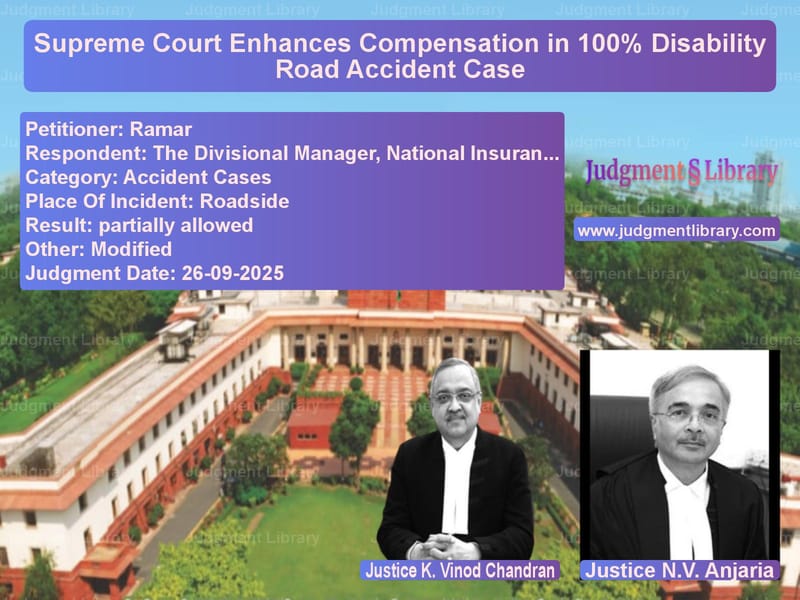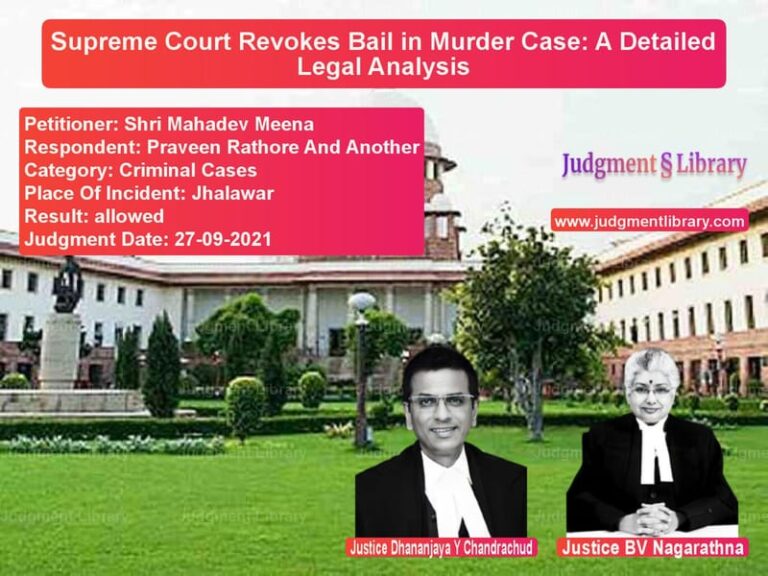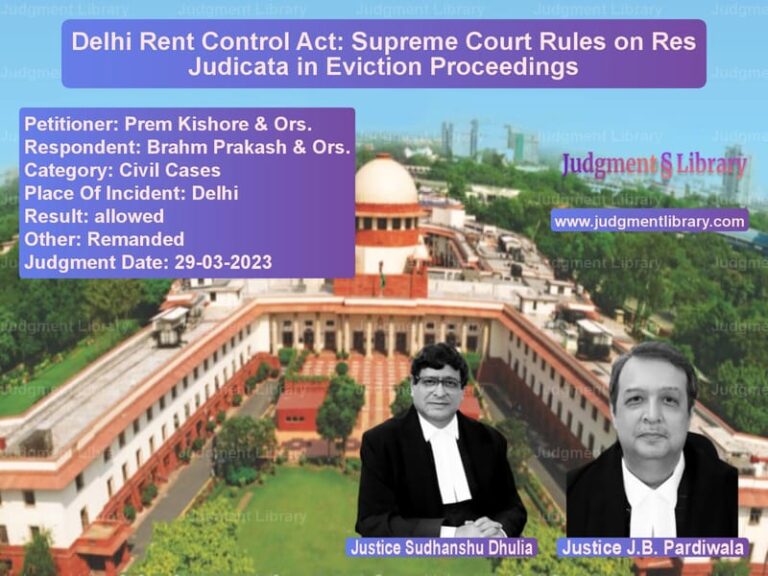Supreme Court Enhances Compensation in 100% Disability Road Accident Case
In a significant ruling that underscores the importance of fair compensation for catastrophic injuries, the Supreme Court of India recently delivered a judgment that partially restored compensation for a man who suffered life-altering injuries in a road accident. The case of Ramar versus The Divisional Manager, National Insurance Company Limited & Anr. represents a crucial examination of how courts should calculate compensation in cases involving permanent disability, particularly when the injured person suffers complete loss of livelihood due to their injuries. The legal journey began with a tragic accident in 2013 and wound its way through multiple judicial forums, each arriving at different conclusions about what constituted fair compensation for the victim’s unimaginable suffering and permanent disability.
The case centered around Ramar, who was standing by the side of the road on January 5, 2013, when a rashly and negligently driven lorry hit him, causing catastrophic injuries. The accident resulted in the amputation of his right leg from the thigh and crushing injuries to his left leg, which left it paralyzed. Medical evidence presented before the Tribunal established that the petitioner suffered 100% functional disability, completely ending his ability to work and lead a normal life. The severity of his injuries meant that he would require lifelong medical care and assistance for even basic daily activities. As the case progressed through the legal system, it became apparent that different judicial authorities had vastly different interpretations of what constituted appropriate compensation for such devastating injuries, particularly regarding income calculation and attendant care costs.
The Legal Journey Through Different Courts
The Motor Accidents Claims Tribunal initially awarded a total compensation of Rs. 17,16,000/-, calculating the petitioner’s monthly income at Rs. 11,000/- and applying a multiplier of 13. This amount was intended to cover various heads of compensation, including loss of future income, medical expenses, pain and suffering, and other related costs. However, the Insurance Company appealed this decision to the High Court, which substantially reduced the compensation amount from Rs. 31,80,350/- to Rs. 20,65,000/-. The High Court’s reduction was primarily based on its decision to lower the monthly income calculation from Rs. 11,000/- to Rs. 6,500/-, citing the precedent set in Syed Sadiq v. Divisional Manager, United India Insurance Company Limited.
Read also: https://judgmentlibrary.com/supreme-court-enhances-compensation-for-100-disabled-accident-victim/
The High Court, while reducing the income figure, did grant a 25% addition for future prospects in accordance with the landmark judgment in National Insurance Company v. Pranay Sethi, thus determining the compensation for loss of income at Rs. 14,62,500/-. However, this still represented a significant reduction from the Tribunal’s award. The High Court also reduced the attendant charges from the amount computed by the Tribunal to a fixed sum of Rs. 1,50,000/-, without providing substantial reasoning for this specific figure. It was these reductions that formed the basis of Ramar’s appeal to the Supreme Court, arguing that the compensation failed to adequately address his lifelong needs resulting from the catastrophic injuries.
The Supreme Court’s Critical Analysis of Income Calculation
The Supreme Court bench comprising Justice K. Vinod Chandran and Justice N.V. Anjaria delved deeply into the issue of income calculation, which formed the cornerstone of the compensation dispute. The Court made a crucial distinction between the precedent cited by the High Court and the facts of the present case, noting that “We notice that Syed Sadiq was a case in which there was no evidence led regarding the income, in which circumstance this Court had adopted an income of Rs.6,500/- for a vegetable vendor that too in the year 2008.” This observation was significant because it highlighted that the Syed Sadiq case involved a complete absence of income evidence, whereas the present case had substantial evidence regarding the petitioner’s earnings.
The Court carefully examined the evidence presented by the petitioner, noting that “In the present case, the accident occurred in the year 2014 and the claimants’ contention was that the deceased was a loading and unloading worker engaged by PW6, who testified that the petitioner would earn between Rs.600 to 1000/- per day. PW7 was a person working along with him as a loading unloading worker, who also spoke in tandem with PW6.” This corroborative evidence from multiple witnesses provided a solid foundation for establishing the petitioner’s income potential.
The Court performed a detailed calculation based on the evidence, observing that “Even if we accept the maximum of the daily wages as spoken of by PW6, it is evident that the total monthly wages claimed is only for 15 days work, i.e., Rs.15,000/-.” However, the Court adopted a balanced approach, considering “the overall circumstances” and concluding that “the income adopted at Rs.11,000/- by the Tribunal is perfectly in order.” This reasoning demonstrated the Court’s commitment to factual accuracy while ensuring that compensation calculations remained realistic and evidence-based.
The Limitations on Enhancement and Future Prospects
An important legal aspect that the Supreme Court had to address was the procedural limitation on the appellant’s claim for enhancement. The Court noted that “there is no appeal filed from the order of the Tribunal by the claimant, despite the fact that he had a claim for future prospects, which stood declined by the Tribunal.” This procedural history created a legal barrier to certain types of enhancements the appellant might have sought.
The Court explained the legal position clearly: “The High Court had while reducing the income considerably awarded future prospects at the rate of 25%. The further appeal now filed by the claimant is against the order of the High Court in the appeal by the Insurance Company. The appellant hence cannot claim any further enhancement than that granted by the Tribunal, nor seek for addition of future prospects.” This ruling highlighted the importance of procedural compliance in litigation and established that appellants cannot seek relief beyond the scope of their appeal, particularly when they had not challenged certain aspects of the original Tribunal order.
The Court’s Reasoning on Attendant Charges
One of the most significant aspects of the Supreme Court’s judgment was its treatment of attendant charges. The Court critically examined both the Tribunal’s and the High Court’s approaches to this crucial component of compensation. The Court observed that “neither the Tribunal was correct in computing the attendant charges on the basis of a regular attendant employed, nor had the High Court offered any reasoning in arriving at Rs.1,50,000/.” This finding indicated that both lower forums had adopted approaches that lacked proper justification.
The Supreme Court recognized the profound impact of the petitioner’s injuries on his daily life, noting that “considering the fact that the petitioner has lost use of his lower limbs, the attendant charges could be computed at Rs.3,00,000/-.” This substantial enhancement reflected the Court’s understanding that a person with 100% disability requiring amputation of one leg and paralysis of the other would need significant lifelong assistance for basic activities. The amount was calibrated to provide meaningful support without being excessively speculative about future needs.
The Final Compensation Breakdown
The Supreme Court provided a detailed breakdown of the modified compensation, demonstrating a comprehensive approach to addressing the various aspects of the petitioner’s losses. The Court retained the Tribunal’s calculation for loss of income at Rs. 17,16,000/-, recognizing the appropriateness of the Rs. 11,000/- monthly income figure. For future medical expenses, the Court awarded Rs. 1,00,000/-, acknowledging the ongoing medical needs resulting from such severe injuries.
The enhanced attendant charges of Rs. 3,00,000/- represented one of the most significant aspects of the modified award. For non-economic damages, the Court awarded Rs. 2,00,000/- for pain and suffering and Rs. 65,000/- for loss of amenities and happiness, recognizing the profound impact on the petitioner’s quality of life. Additional components included Rs. 55,000/- for loss of income during the treatment period, Rs. 25,000/- for transport expenses, and Rs. 25,000/- for extra nourishment during recovery. The total compensation awarded amounted to Rs. 24,86,500/-, representing a balanced approach that addressed both economic and non-economic losses.
Legal Principles and Precedents Applied
Throughout its judgment, the Supreme Court demonstrated careful adherence to established legal principles while adapting them to the specific facts of the case. The Court’s approach to income calculation showed respect for factual evidence while avoiding mechanical application of precedents from factually distinct cases. The judgment reinforced the principle that compensation in motor accident cases must be realistic, evidence-based, and comprehensive enough to address the actual needs of the victim.
The Court’s modification of attendant charges established an important precedent for cases involving severe permanent disabilities, recognizing that such injuries create lifelong needs that must be adequately compensated. The judgment also highlighted the importance of proper reasoning in compensation awards, particularly when modifying amounts determined by lower courts. By requiring substantive justification for changes to compensation components, the Court reinforced the need for judicial decisions to be transparent and rationally grounded.
The Supreme Court’s partial allowance of the appeal, with specific modifications focused on income calculation and attendant charges, represents a nuanced approach to appellate review in compensation cases. The Court respected the findings of the Tribunal where they were well-reasoned and evidence-based, while intervening where the High Court had made unsupported modifications. This balanced approach ensures that compensation awards remain fair and adequate for victims of catastrophic accidents while maintaining consistency and predictability in the legal system.
The judgment concludes with practical directions for implementation, ordering that “The awarded amounts shall be paid after deduction of any amounts already paid with interest @ 7.5% as directed by the Tribunal, commencing from the date of application within a period of three weeks.” This timely disbursement directive ensures that the victim receives the compensation without further delay, recognizing that immediate financial needs are often pressing in cases of severe disability.
Petitioner Name: Ramar.Respondent Name: The Divisional Manager, National Insurance Company Limited & Anr..Judgment By: Justice K. Vinod Chandran, Justice N.V. Anjaria.Place Of Incident: Roadside.Judgment Date: 26-09-2025.Result: partially allowed.
Don’t miss out on the full details! Download the complete judgment in PDF format below and gain valuable insights instantly!
Download Judgment: ramar-vs-the-divisional-manag-supreme-court-of-india-judgment-dated-26-09-2025.pdf
Directly Download Judgment: Directly download this Judgment
See all petitions in Road Accident Cases
See all petitions in Compensation Disputes
See all petitions in Motor Vehicle Act
See all petitions in Negligence Claims
See all petitions in Worksite Accidents
See all petitions in Judgment by K. Vinod Chandran
See all petitions in Judgment by N.V. Anjaria
See all petitions in partially allowed
See all petitions in Modified
See all petitions in supreme court of India judgments September 2025
See all petitions in 2025 judgments
See all posts in Accident Cases Category
See all allowed petitions in Accident Cases Category
See all Dismissed petitions in Accident Cases Category
See all partially allowed petitions in Accident Cases Category







